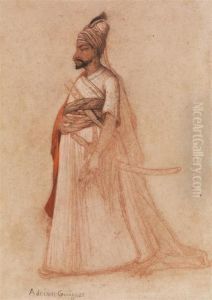Jean Adrien Guignet Paintings
Jean Adrien Guignet was a French historical painter whose life was tragically short, yet impactful in the realm of art. Born in 1816 in Annecy, France, Guignet showed an early talent for drawing and painting. His initial education was not in the arts, but as he grew, his passion for painting became undeniable.
Guignet moved to Paris to pursue his artistic career, where he studied under various established artists of the time, including Paul Delaroche, a prominent French painter known for his grand historical and religious scenes. Under Delaroche's guidance, Guignet honed his skills and developed a passion for history painting, which was considered the most prestigious genre of the time.
His works were characterized by a strong use of color and a dramatic sense of storytelling, qualities that caught the attention of the Parisian art world. Guignet's historical paintings often depicted scenes from antiquity, or from more recent history, rendered with a Romantic sensibility that was in vogue during the mid-19th century.
Despite his potential, Guignet's life was marred by difficulties. He struggled with financial instability and mental health issues, which hindered his ability to work consistently. Sadly, these personal struggles took a toll, and Guignet's life ended prematurely in 1854 when he was only 38 years old.
Guignet's body of work is not extensive due to his short life, but his paintings continue to be appreciated for their emotional depth and technical skill. His works can be found in several French museums, including the Musée du Louvre in Paris. His legacy is that of a talented artist who, despite personal challenges, contributed to the rich tapestry of French Romantic painting.




















